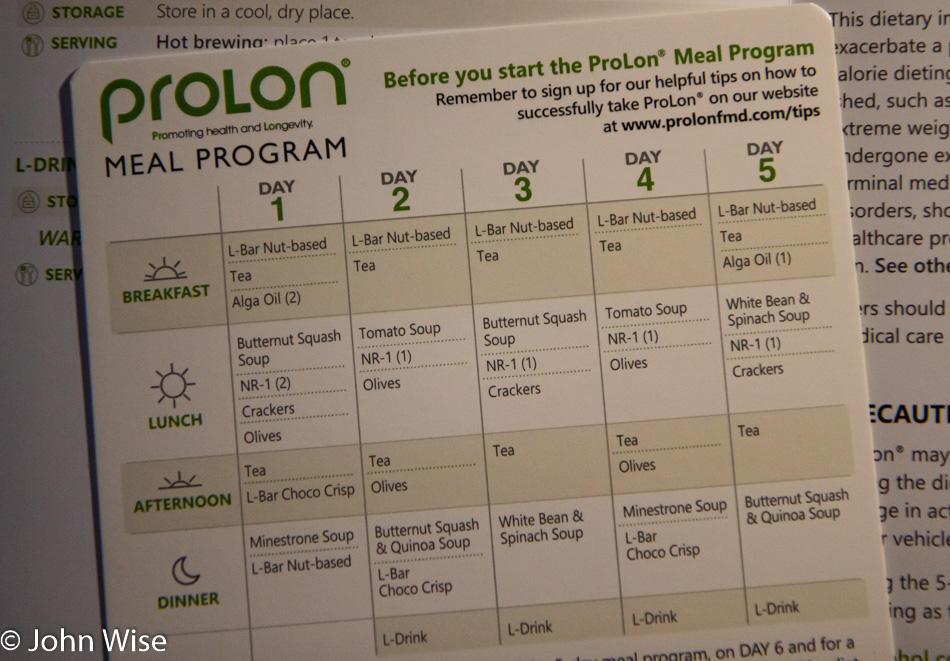
Tomorrow is the day I start the Fasting Mimicking Diet, or FMD, as pioneered by Dr. Valter Longo. Five days of a seriously calorie-restricted diet that is meant to trick the body into reacting as though it were fasting. Science seems to be in agreement that skipping meals and going hungry occasionally does the body a world of good. With things like autophagy, reducing inflammation, helping to normalize blood glucose, and even producing stem cells, this five-day fast is intended to reboot the immune system.
Over the past few weeks, I’ve already practiced a few days of fasting and realized it was easier than I thought to go 24 hours without eating. While I hadn’t anticipated doing this FMD this soon as it is rather expensive, I talked about it with a friend who is going on vacation soon and who took an interest. This other person was adamant that she wasn’t likely to ever delve into fasting in any form but then she read more about it and how it might help with her aches and pains that have developed while leading an extremely active life. Within a day of telling her of my dieting and fasting results and the loss of nearly 10 pounds in two weeks, she did her own research, and while not interested in water-only fasting, she found the FMD plan intriguing.
After reading the available information, she called me asking if I’d be interested in going in on a “Buy 2 Get 1 Free” deal that was expiring in a couple of days. Which was great in that it dropped the price for my one box from $249 to $166, so I said sure. Next, she volunteered that she was going to get to the diet the Monday following our shipment; I suggested that I start it at the same time. Now we have someone else to commiserate with should this prove difficult.
ProLon is the name of a meal plan and is an elegant box with all five days of nutrition conveniently measured and packaged by what is supposed to be consumed by meal and day. This pricey box of foods meets the strict guidelines that Dr. Longo discovered in his research, where the first day of the diet has the caloric parameters of 34% carbs, 10% protein, 56% fat, and subsequent days change to a formulation that breaks down into 47% carbs, 9% protein, and 44% fat calories.
With calories tightly restricted with the above formulation, we will eat approximately 1,100 calories on the first day and about 800 calories each of the next four days.
As I go into this, my weight is 226.8. Back on September 13th, I weighed in at 242 pounds, so I’ve lost 15 pounds (about 7kg) in a little more than three weeks. With a BMI of 31.6, I’m obese, but hopefully, within the week, I’ll simply be overweight. My blood glucose in early September was exceptionally high, with an estimate that my average for the week prior to my doctor’s visit was about 270mg/dl, which was verified when I found out that my A1C was an unhealthy 9.5%. During the past week, my blood glucose has averaged just 103mg/dl; keep in mind that I’ve done a few fasting days in the past 24 days to get here. My resting heart rate back in early September was about 62, now it’s averaging 55 for the past week. On September 13th, I’d been averaging under 2 miles walked per day, while for the past few weeks, I’ve been walking between 5 and 7 miles per day.
Over the next five days, I’ll be weighing in each day within a couple of minutes of waking. After that and a glass of water, I’ll head out for a 1 to 2-mile walk. Time to check my blood glucose level and then eat my meager breakfast. Two hours after eating, I’ll check my blood glucose levels again to measure my postprandial levels (after eating). Before lunch, I’ll be walking another mile or two, and after eating, I’ll be checking my blood glucose along with measuring my ketones. Following dinner, it will be time to take my final mile or two walks around the block and then measure the glucose yet again.